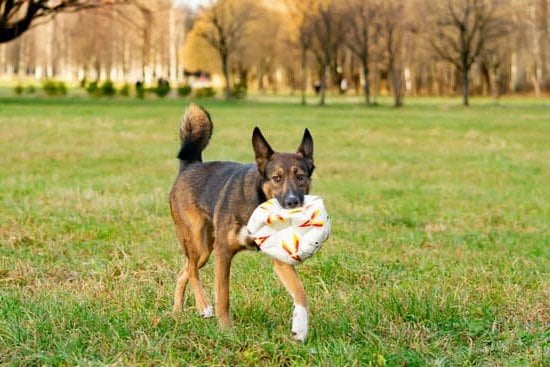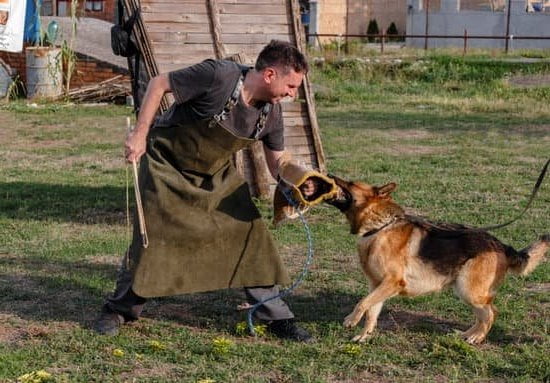Having a dog that bites can be a frustrating and potentially dangerous situation. Whether your dog is biting out of fear, aggression, or playfulness, it is crucial to address this behavior early on to ensure the safety of both yourself and others.
In this article, we will explore the various reasons why dogs bite and how to recognize the warning signs. We will also delve into proven methods for training your dog not to bite, emphasizing the importance of trust and leadership in the process.
No pet owner wants their furry companion to pose a risk or cause harm. By understanding why dogs bite and how to prevent it, you can create a harmonious household and establish a strong foundation for successful training. Identifying early warning signs is essential in curbing biting tendencies before they escalate. By paying attention to your dog’s body language and behavior cues, you can intervene proactively and effectively discourage biting.
Establishing trust and leadership is crucial when training your dog not to bite. Dogs are pack animals by nature, seeking guidance from their owners on acceptable behaviors. Through consistent training techniques focused on positive reinforcement, you can teach your dog alternative behaviors instead of resorting to biting. Additionally, we will discuss the importance of socialization in reducing biting tendencies and promoting healthy interactions with other dogs and humans.
Training your dog not to bite requires patience, consistency, and dedication. Positive reinforcement techniques will be explored as effective tools in encouraging non-biting behavior in dogs. Furthermore, we will discuss when it may be necessary to seek professional help from a certified trainer or behaviorist if biting issues persist despite your efforts.
Lastly, we will provide important safety precautions that should be taken during the training process to ensure personal safety for both you and your furry friend. It is vital to realize that stopping dog biting behavior is not only about creating a bite-free environment but also about strengthening the bond between you and your dog.
Why Do Dogs Bite
Dogs biting can be a common and concerning behavior issue for many dog owners. Understanding the root causes behind biting behavior is crucial in effectively addressing and preventing it.
One of the main reasons why dogs bite is due to fear or aggression. Dogs may feel threatened or anxious in certain situations, causing them to respond defensively by biting. It is important to remember that dog aggression is often a result of the situation they are in, rather than being an inherent trait of their personality.
Another reason for biting behavior is pain or discomfort. Dogs may resort to biting as a way to communicate their discomfort or protect themselves from further pain. This can be seen in situations where a dog has an injury or is experiencing health issues.
Territoriality is also another common cause of biting behavior in dogs. Dogs are naturally protective of their space and resources, which may include their home, food, toys, or even their owner. If they perceive someone as a threat to these resources, they may respond with aggression and biting.
It is also important to note that some breeds are more prone to aggressive behavior due to their genetic predisposition. Additionally, factors such as poor socialization during puppyhood or previous traumatic experiences can contribute to aggressive tendencies and biting behavior.
To address and prevent biting behavior effectively, it is essential to identify the specific trigger or cause behind the aggression. By understanding why your dog bites, you can tailor your training approach accordingly and implement appropriate techniques to modify their behavior.
| Root Cause | Description |
|---|---|
| Fear/Aggression | Dogs may feel threatened or anxious in certain situations. |
| Pain/Discomfort | Dogs may bite when they are experiencing pain or discomfort. |
| Territoriality | Dogs may bite to protect their resources or personal space. |
| Genetic Predisposition | Some breeds are more prone to aggressive behavior due to genetics. |
| Poor Socialization/Traumatic Experiences | Lack of socialization or previous traumatic experiences can contribute to aggression. |
Identifying Early Warning Signs
Knowing the early warning signs that indicate your dog is about to bite can help prevent potentially dangerous situations and allow you to address the issue before it escalates. Dogs usually display several cues before resorting to biting, which gives you an opportunity to intervene and redirect their behavior. Here are some key indicators to watch for:
- Body language: Pay close attention to your dog’s body language as it can provide valuable information about their state of mind. A stiff or frozen body posture, raised hackles, pinned back ears, and a tense facial expression are signs that your dog may be feeling threatened or anxious.
- Growling or snarling: Vocalizations like growling or snarling are clear indicators that your dog is uncomfortable and may escalate to biting if the situation doesn’t change. Take these vocalizations seriously and address the underlying cause of your dog’s distress.
- Signs of fear or anxiety: Dogs often exhibit behaviors such as panting excessively, yawning, or trying to escape when they feel scared or anxious. If you notice these signs in your dog, it’s important to create a calm and reassuring environment for them.
- Aggressive posturing: When dogs are preparing to bite, they may adopt defensive or offensive postures such as lunging forward with their teeth bared, showing stiff body posture while standing tall, or giving direct eye contact.
In order to effectively recognize these warning signs and respond appropriately, it’s crucial for owners to invest time in understanding their dog’s unique body language and behavior patterns. By familiarizing yourself with these signals and remaining vigilant during interactions with your dog, you can proactively address any potential biting situations.
| Early Warning Sign | Description |
|---|---|
| Stiff or frozen body posture | Indicates that the dog is feeling threatened or anxious. |
| Growling or snarling | Vocalizations that show discomfort and potential escalation to biting if not addressed. |
| Signs of fear or anxiety | Panting excessively, yawning, or trying to escape are signs of fear or anxiety that can precede biting behavior. |
| Aggressive posturing | Lunging forward with teeth bared, showing stiff body posture, and direct eye contact are signs of aggressive posturing before a potential bite. |
Being able to identify these early warning signs will allow you to take appropriate action and prevent your dog from biting. If you observe any of these behaviors in your dog, it is important to remain calm and avoid any sudden movements or aggressive reactions. Instead, try the following strategies:
- Remove the trigger: If possible, remove whatever is causing your dog’s unease or anxiety. This could be a loud noise, an unfamiliar person, or another animal.
- Create distance: Give your dog space by moving away from the triggering situation. Distance will help alleviate their stress and reduce the likelihood of biting.
- Use positive reinforcement: Reinforce calm and relaxed behavior through praise and rewards. This will help your dog associate positive experiences with situations that previously made them uncomfortable.
Remember, every dog is unique, so it’s important to personalize your approach based on their individual temperament and personality. By being attentive to your dog’s body language and responding appropriately when you notice early warning signs, you can effectively prevent instances of biting and create a safer environment for both you and your beloved pet.
Establishing Trust and Leadership
Creating a Positive and Consistent Environment
Establishing trust and leadership is crucial when training your dog to stop biting. Dogs are pack animals and rely on their owners to provide guidance and structure. By creating a positive and consistent environment, you can build a strong foundation for successful training.
Consistency is key in every aspect of your interactions with your dog. Set clear rules and boundaries from the beginning and stick to them. Be consistent in your commands, rewards, and punishments to avoid confusion for your dog. Use positive reinforcement techniques such as treats, praise, and toys to reward good behavior while ignoring or redirecting negative behavior.
It’s also important to establish yourself as the leader of the pack. Dogs instinctively look for a leader and will often take on this role themselves if one is not provided. By being firm, confident, and assertive, you can show your dog that you are the one in charge. This will help prevent biting behaviors fueled by dominance or a lack of boundaries.
Building Trust through Bonding Activities
To establish trust with your dog, it’s important to engage in bonding activities that promote a positive connection between you both. Spend quality time together engaging in activities such as playtime, grooming sessions, or training exercises.
Positive reinforcement is essential during these bonding activities. Reward your dog for following commands or exhibiting desired behavior with treats or praise. This will reinforce their understanding that good behavior earns positive outcomes.
To foster trust, avoid using harsh punishments or physical force that may cause fear or harm to your dog. Instead, focus on building a relationship based on trust, respect, and mutual understanding.
Providing Mental Stimulation
Dogs who are bored or unstimulated are more likely to engage in biting behavior as a way of releasing energy or seeking attention. Providing mental stimulation is essential for preventing boredom-related biting.
Include regular exercise in your dog’s routine to release their physical energy. This can be accomplished through walks, runs, or playtime. In addition to physical activities, provide mental stimulation through puzzle toys, treat-dispensing toys, or training exercises. This will keep your dog mentally engaged and less likely to resort to biting as a form of entertainment.
By consistently creating a positive environment, establishing yourself as the leader, engaging in bonding activities, and providing mental stimulation for your dog, you will build a strong foundation for successful training and decrease the likelihood of biting behavior. Remember that building trust takes time and patience, so be consistent in your efforts while remaining calm and loving with your furry friend.
Essential Training Techniques
One of the most important aspects of training your dog to stop biting is understanding the underlying causes of this behavior. Dogs may bite due to fear, pain, frustration, or a desire to protect their territory or loved ones. By addressing these root causes, you can effectively train your dog not to bite.
First and foremost, it is crucial to establish yourself as the leader in your dog’s life. Dogs are pack animals and they respond well to clear leadership. This means consistently enforcing rules and boundaries, providing positive reinforcement for good behavior, and avoiding any form of physical punishment or aggression towards your dog.
Positive reinforcement techniques are highly effective in training dogs not to bite. Reward-based training focuses on rewarding good behavior rather than punishing bad behavior. Whenever your dog displays non-biting behavior, such as licking instead of biting or responding well to a “leave it” command, praise them and offer a treat or verbal reward. This helps reinforce the idea that non-biting behavior is desirable and will result in positive outcomes.
Consistency and patience are key ingredients for successful training. It’s important to remember that changing any behavior takes time and effort. Be consistent with your training methods and expectations, ensuring that all family members are on board with the process. Patience is also necessary as dogs learn at their own pace. Celebrate small victories along the way and have faith that with consistent training, your dog will eventually stop biting.
To further enhance your dog’s socialization skills and reduce biting tendencies, expose them to various situations and environments from an early age. Gradually introduce new people, animals, sights, sounds, and objects so that they become familiar with different stimuli without feeling threatened or anxious. Socialization helps dogs feel more comfortable in different scenarios and reduces their need for defensive biting.
| Training Technique | Description |
|---|---|
| Positive Reinforcement | Rewarding good behavior with treats, praise, or verbal rewards to encourage non-biting behavior. |
| Consistency | Being consistent in training methods and expectations to help your dog understand what is expected of them. |
| Patient Training | Giving your dog time to learn and change their behavior without becoming frustrated or discouraged. |
| Socialization | Exposing your dog to different situations and environments to help them become more comfortable and less defensive. |
By following these essential training techniques, you can teach your dog not to bite and create a safer and more harmonious bond between you and your furry companion. Remember that seeking professional help from a certified dog trainer or behaviorist is always an option if you are struggling with training or if the biting behavior persists despite your efforts.
With patience, consistency, positive reinforcement, and a commitment to understanding the underlying causes of biting behavior, you can successfully train your dog not to bite.
Socialization Matters
What is Socialization?
Socialization plays a critical role in shaping a dog’s behavior and reducing biting tendencies. It involves exposing your dog to a wide range of people, animals, environments, and experiences from an early age. The goal of socialization is to help your dog feel comfortable and confident in different situations, preventing fear-based aggression and reactive behaviors.
The Benefits of Socialization
Properly socializing your dog can have numerous benefits when it comes to reducing biting tendencies. Here are some key advantages:
- Improved Confidence: Socialization helps build your dog’s confidence by exposing them to new situations in a controlled manner. Regular exposure to different environments, people, and animals can teach your dog that there is nothing to fear, reducing the likelihood of defensive or aggressive behavior.
- Enhanced Communication Skills: Through socialization, dogs learn how to communicate effectively with both humans and other animals. They develop better body language understanding, impulse control, and appropriate ways to interact with others. This can lead to more positive interactions and reduce the risk of biting due to miscommunication or frustration.
- Decreased Anxiety and Fear: Dogs that lack proper socialization may develop anxiety or fear towards unfamiliar people or situations. This fear can manifest as aggressive behavior such as biting as a defense mechanism. By gradually exposing them to new experiences under controlled conditions, you can help alleviate their anxieties and reduce the likelihood of biting incidents.
How to Socialize Your Dog
When it comes to socializing your dog for bite prevention, certain considerations should be taken into account:
- Start Early: Ideally, socialization should begin during the critical period between 3-14 weeks of age when puppies are most receptive to new experiences. However, older dogs can still benefit from proper socialization.
- Gradual Exposure: Introduce your dog slowly and gently to various environments, people, and animals. Start with low-stress situations and gradually increase the level of challenge as they become more comfortable.
- Positive Reinforcement: Ensure that socialization experiences are positive for your dog by using treats, praise, and rewards to reinforce good behavior. This will help them associate new experiences with positivity and further reduce the risk of aggressive behaviors.
- Controlled Environments: When introducing your dog to new situations or environments, it’s crucial to do so in a controlled manner. This may involve using a leash or harness to ensure their safety and prevent any negative incidents.
By incorporating socialization into your training regimen, you can significantly reduce your dog’s biting tendencies and promote healthy interactions with others. However, socialization alone may not completely eliminate biting behavior. It should be combined with other training techniques and addressed holistically to achieve the best results.
Effective Bite Inhibition Training
One of the most important aspects of training your dog to stop biting is teaching them bite inhibition. Bite inhibition refers to a dog’s ability to control the force of their bites, allowing them to use a gentler mouth during play or other interactions. Not only does this prevent injuries, but it also helps your dog understand what is acceptable behavior in terms of biting.
To start bite inhibition training, it is essential to begin at a young age when puppies have softer mouths and are less likely to cause harm. One effective method is to provide feedback when a puppy bites too hard. When they bite too forcefully during play or interaction, let out a high-pitched yelp or say “ouch” in a loud and exaggerated manner. This mimics how another puppy would react if bitten too hard during play.
By providing this feedback, you are teaching your dog that biting with excessive force leads to negative consequences – playtime ends. You can then ignore your puppy for a few minutes before resuming play again. Repeat this process consistently whenever your dog bites too hard, and reinforce gentle mouthing by continuing play when they use an appropriate amount of pressure. Over time, your dog will learn that gentler mouthing leads to continued play and positive reinforcement.
It’s important to note that consistent and patient practice is necessary for successful bite inhibition training. Training sessions should be short but frequent, allowing your dog multiple opportunities to learn and practice controlling the force of their bites. With time and positive reinforcement, you will develop a strong foundation where your dog understands how to inhibit their biting behavior effectively.
By implementing effective bite inhibition training early on and reinforcing it throughout your dog’s life, you can ensure they have better control over their mouth and reduce the risk of serious injuries from biting incidents. Remember, patience and consistency are key in this process, so be sure to stay dedicated to helping your dog develop bite inhibition skills.
Positive Reinforcement Techniques
Positive reinforcement techniques can be highly effective in training your dog to stop biting. By using reward-based approaches, you can encourage your dog to exhibit non-biting behavior and strengthen the bond between you.
Understanding Positive Reinforcement
Positive reinforcement involves rewarding your dog for displaying desired behaviors. This training technique is based on the principle that dogs are motivated by rewards and will repeat behaviors that lead to positive outcomes. When it comes to stopping biting behavior, positive reinforcement focuses on rewarding your dog for not biting rather than punishing them for biting.
Choosing the Right Rewards
In order for positive reinforcement to work effectively, it’s important to use rewards that your dog finds highly motivating. This could be a treat, a favorite toy, or even verbal praise and affection. Experiment with different types of rewards to determine what works best for your dog. It’s also crucial to deliver the reward immediately after the non-biting behavior occurs so that it is associated with the correct action.
Implementing Positive Reinforcement Techniques
To start using positive reinforcement to discourage biting, identify situations where your dog typically bites and establish clear boundaries. Whenever your dog refrains from biting in these situations, immediately reward them with a treat or praise. Consistency is key – make sure you reward non-biting behavior every time it occurs.
Additionally, you can use clicker training alongside positive reinforcement techniques. The clicker serves as an auditory cue that signals to your dog that they have done something correctly and will receive a reward. Pair the clicker sound with non-biting behavior followed by an immediate reward. Over time, your dog will associate the clicker with receiving a reward and this can help reinforce their understanding of what behaviors are desirable.
By utilizing positive reinforcement techniques consistently and providing frequent rewards when your dog refrains from biting, you can encourage them to adopt non-biting behavior more readily. This approach not only helps to discourage biting but also strengthens the bond between you and your furry friend. Remember, patience and consistency are key in achieving long-term success when using positive reinforcement in dog training.
Consistency and Patience
When it comes to training your dog to stop biting, consistency and patience are two essential ingredients for long-term success. Dogs learn through repetition and reinforcement, so it’s important to remain consistent in your approach and expectations. Additionally, patience is crucial as changing behavior takes time and effort.
To maintain consistency in your training, establish clear rules and boundaries from the beginning. Make sure everyone in the household follows these rules consistently to avoid confusing your dog. For example, if you don’t want your dog to bite while playing, never allow them to play bite even during playtime. Consistently reinforce the desired behavior by redirecting their attention to a toy or treat whenever they start biting.
Patience is key when it comes to curbing biting behavior. Remember that training takes time and progress may not happen overnight. Be patient with your dog and yourself as you navigate this process together. Avoid punishment-based techniques as they can damage the trust between you and your furry friend.
In addition to consistency and patience, it’s important to stay positive throughout the training process. Use positive reinforcement techniques such as treats or praise whenever your dog demonstrates non-biting behavior. This will encourage them to continue behaving appropriately.
By consistently reinforcing boundaries, remaining patient, and using positive reinforcement techniques, you will be well on your way to long-term success in curbing biting behavior. Remember, every dog is unique, so tailor your methods accordingly based on their individual needs and personality traits.
Seeking Professional Help
While many dog owners can successfully address biting issues through training and socialization, there may be times when seeking professional help is necessary. Consulting a dog trainer or behaviorist can provide valuable guidance and expertise in addressing biting problems that may be more complex or severe. Here are some situations in which it is recommended to seek professional help:
- Persistent or Aggressive Biting: If your dog’s biting behavior persists despite your consistent efforts to train and discourage it, professional intervention may be necessary. Dog trainers and behaviorists have the knowledge and experience to handle aggressive behaviors and can assess the underlying causes of the biting.
- Fear or Anxiety-Related Biting: Dogs that bite out of fear, anxiety, or stress require specialized help from professionals who understand these behavioral issues. A dog trainer or behaviorist can create a tailored training program that focuses on reducing fear and anxiety and teaching alternative coping mechanisms.
- Injuries Caused by Biting: If your dog’s biting has resulted in injuries to yourself or others, it is crucial to seek assistance from a professional immediately. They can assess the severity of the situation, provide guidance on managing wounds, and develop a comprehensive plan to prevent future incidents.
When consulting a dog trainer or behaviorist for biting issues, there are some key factors to consider:
- Qualifications and Experience: Look for professionals who have relevant certifications, experience handling biting behaviors, and success stories that align with your specific needs. Ask for referrals from other dog owners who have sought similar help.
- Positive Reinforcement Techniques: Ensure that the professional uses positive reinforcement methods rather than harsh punishments or aversive techniques. Reward-based approaches have been proven effective in modifying behaviors without causing harm or inducing fear.
- Individualized Training Plan: The trainer should create an individualized training plan based on your dog’s unique needs and circumstances. This plan should address the root causes of biting while considering any underlying medical conditions or environmental factors.
Remember, seeking professional help is not a sign of failure as a dog owner. It demonstrates your commitment to addressing the issue and ensuring the safety and well-being of both yourself and your dog. With the guidance of a trained professional, you can work towards a bite-free future and strengthen the bond with your furry friend.
Safety Precautions
Training a dog to stop biting can be a challenging and potentially unsafe task. It is important to prioritize personal safety during the training process to prevent injuries. Here are some crucial safety precautions to take while training your dog:
- Use Protective Gear: When starting to train your dog, it is wise to wear long sleeves, pants, and closed-toe shoes to protect yourself from potential bites or scratches. Investing in thick gloves can also provide an extra layer of protection.
- Avoid Physical Punishment: It is essential to remember that using physical punishment as a training method can escalate aggression in dogs. Instead, opt for positive reinforcement techniques such as treats, praise, and toys when your dog exhibits non-biting behavior.
- Enlist Professional Help When Needed: If your dog’s biting behavior seems uncontrollable or becomes dangerous, do not hesitate to seek assistance from a professional dog trainer or behaviorist. They have experience in dealing with such issues and can provide guidance on how to address the problem safely and effectively.
- Socialize Safely: Socializing your dog with other pets and people is crucial for reducing biting tendencies. However, it is important to introduce these situations gradually and in a controlled environment. Always monitor interactions closely and intervene if necessary.
- Set Boundaries: Establishing boundaries with your dog is key to ensuring personal safety during training sessions. Use physical barriers such as baby gates or crates when needed, especially if you have children or visitors at home who may be at risk of being bitten.
- Utilize Leashes and Muzzles: For dogs with a high tendency of biting, using leashes or muzzles during training sessions can provide an extra level of safety for both you and others around you.
By implementing these safety precautions while training your dog not to bite, you can minimize the risk of harm and create a safer environment for everyone involved in the process. Remember that patience, consistency, and positive reinforcement techniques are vital in achieving long-term success and strengthening the bond with your furry friend.
Conclusion
In conclusion, training your dog to stop biting is crucial for both their safety and the well-being of those around them. By understanding the root causes behind biting behavior and recognizing early warning signs, you can take proactive steps to prevent potential incidents. Building trust and establishing yourself as a strong leader are vital in creating a foundation for successful training.
Essential training techniques, such as teaching bite inhibition control and using positive reinforcement, can effectively discourage biting behavior. Consistency and patience are key throughout the training process, as it may take time for your dog to fully grasp the desired behavior. It is also important to expose your dog to various situations through socialization, which can help reduce biting tendencies.
While many dog owners can successfully train their dogs not to bite using these methods, there may be cases where professional help is needed. Consulting a dog trainer or behaviorist can provide valuable expertise in addressing more complex or severe biting issues.
Throughout the entire training process, it is crucial to prioritize safety precautions to ensure personal well-being. This includes using appropriate protective gear when necessary and being cautious when working with an aggressive dog.
By embracing a bite-free future through effective training techniques and understanding the importance of addressing biting behavior, you will not only ensure the safety of yourself and others but also strengthen the bond with your dog. Remember that consistent effort and patience are key in achieving long-term success in curbing biting behavior. With dedication and proper guidance, you can create a harmonious relationship with your furry companion based on trust and mutual respect.
Frequently Asked Questions
How do you discipline a dog to stop biting?
Discipline is an essential aspect of training a dog to stop biting. The first step is to establish clear boundaries and consistently enforce them. This can be done through positive reinforcement techniques such as rewarding good behavior with treats or praise, while redirecting or ignoring unwanted biting behavior.
It’s important to never resort to physical punishment, as this can lead to fear or aggression in the dog. Consistency and patience are key when discipline becomes necessary, incorporating commands like “no” or “leave it” and reinforcing them each time the dog bites inappropriately.
Why does my dog keep biting me?
There could be several reasons why a dog keeps biting its owner. It’s crucial to understand that dogs communicate through their behaviors, including biting, so it might be an indication of some underlying issue. Dogs often bite due to fear, anxiety, stress, frustration, or even overexcitement.
They might also bite if they perceive a threat or feel their personal space is being invaded. Additionally, puppies tend to explore the world with their mouths and might nip during play as they learn boundaries. Identifying the root cause behind the biting behavior is crucial in addressing and preventing it from persisting.
Do dogs feel bad after they bite you?
Dogs have complex emotions but attributing human-like feelings of guilt or remorse after biting may not be accurate. While every dog is different in how they react after biting someone, most dogs do not feel guilt as humans do since it requires self-awareness and reflection on past actions.
However, dogs are highly intuitive animals that can sense changes in human body language and mood; therefore, they may display signs of fear, submission, confusion, or anxiety after a bite incident. These emotional reactions are more likely linked to their perception of the consequences than experiencing true guilt for their actions.

Welcome to the blog! I am a professional dog trainer and have been working with dogs for many years. In this blog, I will be discussing various topics related to dog training, including tips, tricks, and advice. I hope you find this information helpful and informative. Thanks for reading!





